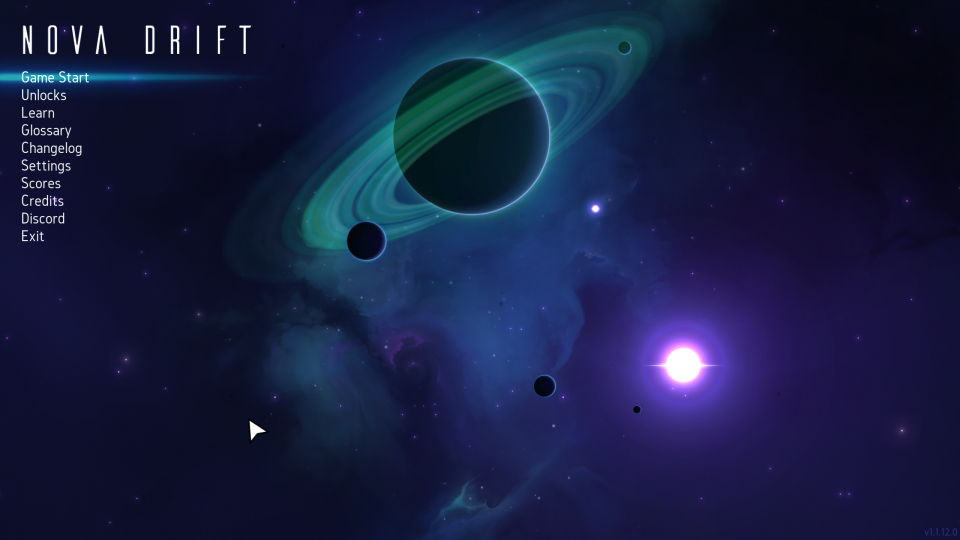After sinking 12 hours into Nova Drift, an indie rogue-lite that channels the spirit of Atari classics like Asteroids, I’ve enjoyed my time with it, but not without reservations. This arcade-inspired space shooter, developed by Chimeric and published by Pixeljam, delivers a no-frills experience that’s both thrilling and occasionally repetitive. While its core loop is addictive, it sometimes struggles to hold attention—until clever unlocks and progression systems pull you back for another run. Here’s my take on this modernized retro gem.
Developer & Publisher // Chimeric, Pixeljam
Platform // PC
MSRP & Release Date // $17.99, August 12, 2025
Reviewed On // PC
Controls — A Classic Feel
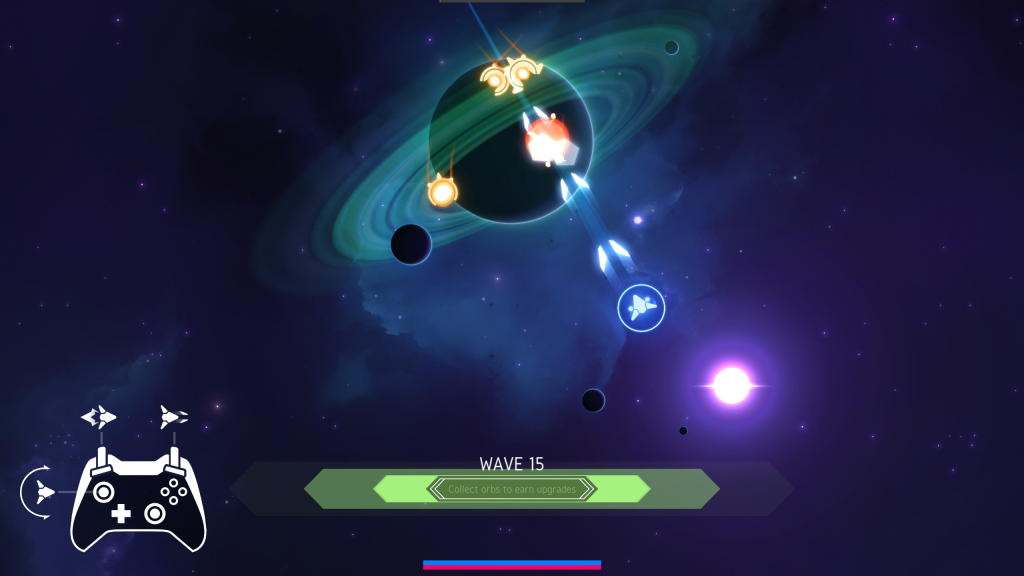
At its core, Nova Drift is a survival rogue-lite vaguely reminiscent of Brotato or Vampire Survivors, where you endure relentless enemy waves in a single, unchanging deep-space arena.
I played Nova Drift exclusively on controller. You control your ship with the left stick to steer, left trigger to thrust, and right trigger to fire. Sounds straightforward, but mastering momentum is half the battle. Your ship’s thrusters carry inertia, and holding the thrust can send you careening into danger. Pro tip: tap the trigger for precise control to avoid overshooting into enemy fire.
The screen’s edges loop, meaning flying off the top re-enters you from the bottom—a mechanic that’s both a lifesaver and a hazard. It’s great for dodging bullet-hell boss attacks that flood half the screen, but misjudge your path, and you’ll warp straight into an enemy or projectile. The minimalist arena, with stars and planets drifting in the background, can feel monotonous after hours, but it’s a minor gripe for an arcade purist.
Gameplay Loop — Almost Standard
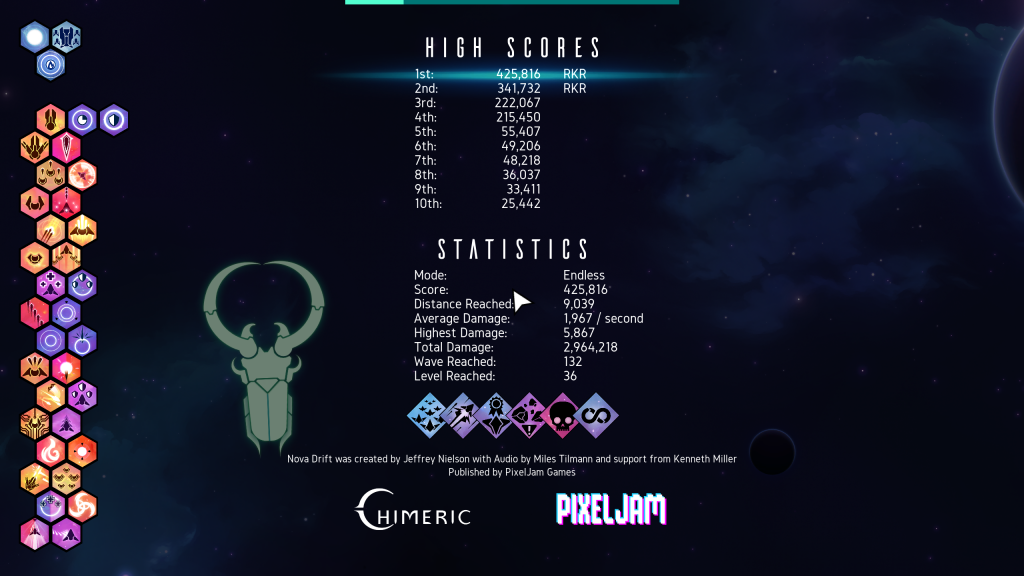
Gameplay revolves around surviving waves, racking up scores, and restarting after death. A classic leaderboard lets you input initials to track high scores locally, but the absence of a global leaderboard in-game feels like a missed opportunity.
Competing against myself lacks the spark a worldwide ranking could provide. Still, the rogue-lite structure keeps things fresh with randomized enemy waves, gear, mods, and anomalies like the Singularity (a vacuuming black hole) or meteors that smash through the stage.
Nova Drift shines through its layered progression systems, which give each run purpose and variety. There are three systems of progression that will keep you coming back for more after each death.
Waves and Enemy Types — Constant Danger
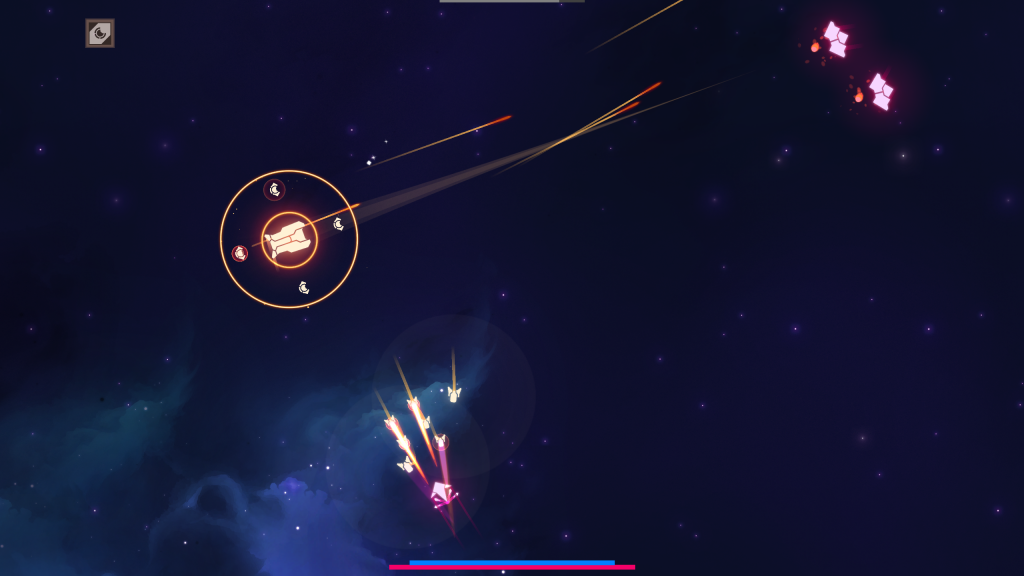
Progression starts with surviving waves, which grow tougher with more enemies and varied types. From swarms of fragile ships to tanky, shielded foes that only expose weak points when attacking, the roster keeps you on your toes. Standout enemies include:
- Hammerheads – Ships that explode in high-damage bursts when destroyed or approached. They chase you down and detonate if left alone for a period of time.
- Wardens – Arrive in droves and fire a single shot that can easily break your shield in the early game. It will escape if not destroyed in time.
- Tracers – Nimble, mine-dropping ships that litter the field with hazards and will not let you shoot them down without a fight. Deadly in groups—prioritize these.
Bosses appear at set intervals, culminating in a brutal final boss at Wave 120 that ends the run if you come out victorious. The difficulty ramps up steadily, but the game feels fair, rewarding skill and strategy. Enemy variety and anomalies ensure no two runs feel identical.
Gear — Defining Your Ship’s Core
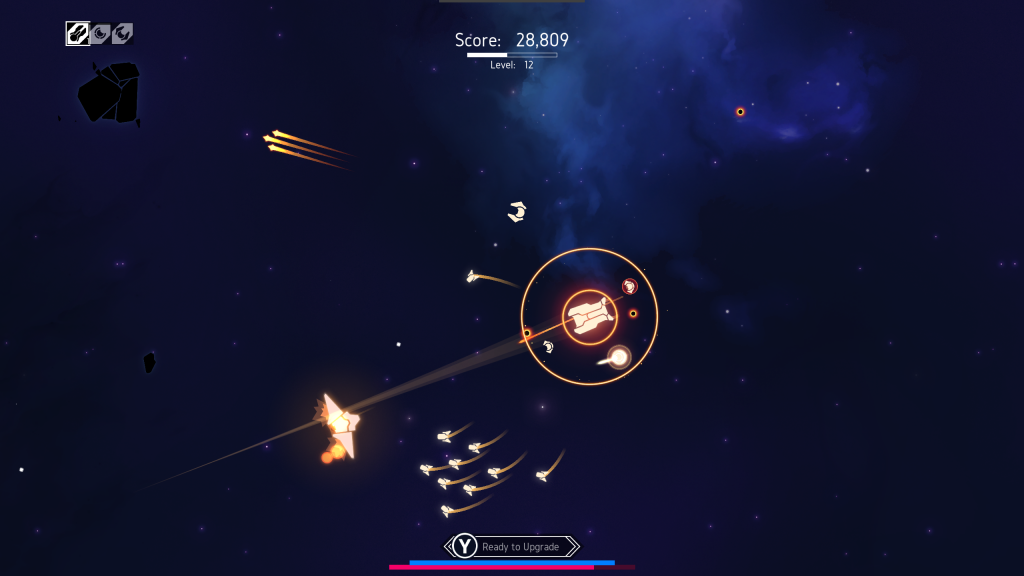
Gear is the second form of progression in Nova Drift and is the foundation of your ship’s build, consisting of three categories—Weapons, Shields, and Body—with only one of each equippable at a time, swappable upon leveling up (earned by collecting XP from enemies and asteroids). Each category offers diverse options that shape your playstyle, encouraging experimentation to find synergistic combinations.
Weapons
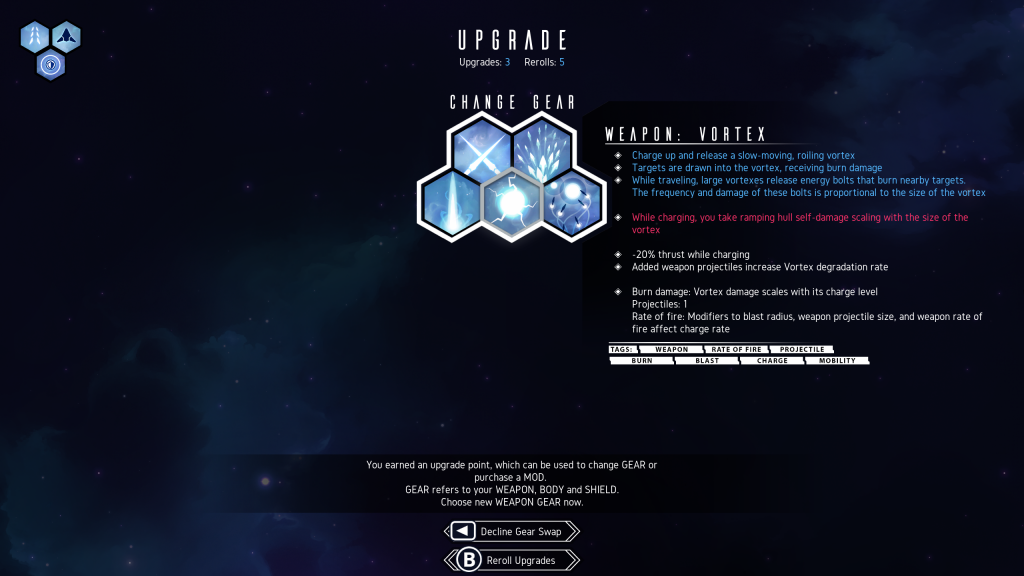
Your primary damage source, with options for every range and skill level. Ranging from long-range, precision-based weapons like the Railgun to close-range, melee weapons like Swords. Some standouts include:
- Salvo – Heat-seeking missiles that auto-target, ideal for players who prefer less precise aiming. They struggle against fast enemies but excel in crowded waves, letting you focus on dodging.
- Flak – A close-range shotgun burst that one-shots weaker foes with precise hits. It’s high-risk, high-reward, requiring you to weave through enemy patterns but devastating when mastered.
- Thermal Lance – A medium-range beam that burns through enemies, dealing bonus burn damage over time. It demands skilled piloting to keep the beam on target, especially against mobile foes, but melts tanky ships.
- Pulse – My personal favorite, a short-range 360-degree burst that triples damage at point-blank range. It’s perfect for aggressive players who thrive in the chaos, though it leaves you vulnerable to long-range attacks.
Shields
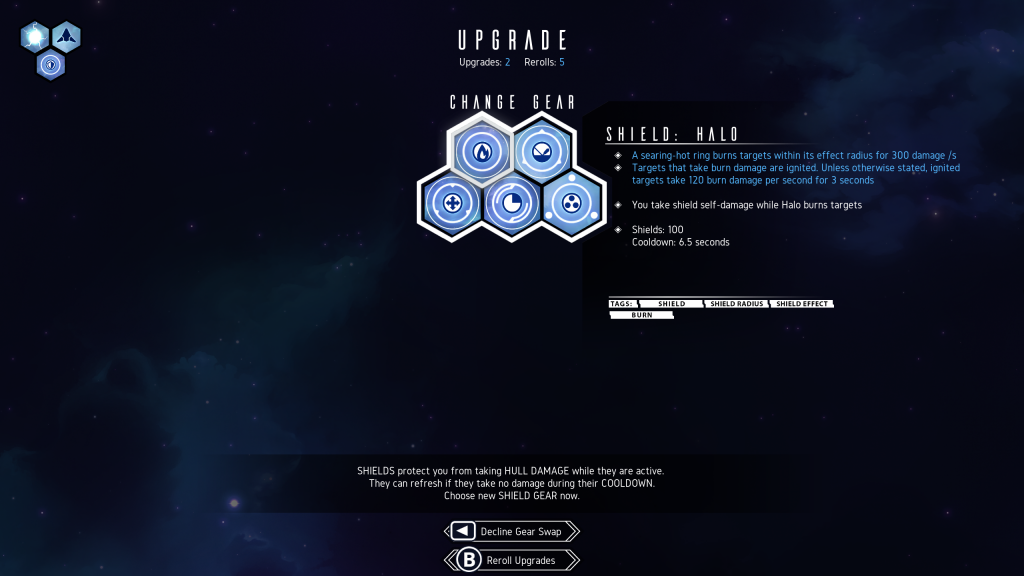
Your first line of defense. Shields will take the hit first when receiving damage. They automatically regenerate after a cooldown if undamaged, similar to Halo: Combat Evolved. Whether a scratch or they’re completely obliterated, once the cooldown completes, your shields will instantly regenerate to maximum.
Shield Gears come in many shapes and forms, offering tactical variety:
- Amp – Boosts your weapon damage or speed while the shield is active, encouraging aggressive play to keep it intact. It’s a gamble, as a single hit resets the bonus.
- Reflect – Repels enemy projectiles when boosting, turning defense into offense. It’s great for bullet-hell moments but requires precise timing to maximize.
- Bastion – A high-capacity shield with slower regen, ideal for tanky builds. It absorbs heavy hits but leaves you vulnerable during long cooldowns.
- Halo – A ring-shaped shield that scorches nearby enemies, doubling as a close-range weapon. It synergizes with melee builds like Pulse, amplifying damage when you’re in the thick of it.
Body
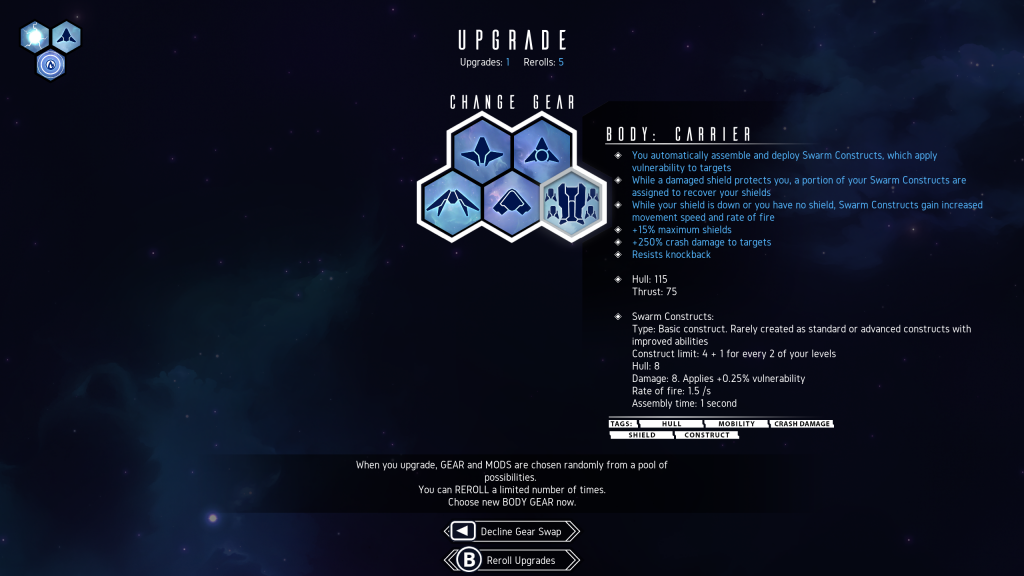
This gear isn’t the most flashy, but it can make or break your build. It boosts or reduces your health (hull) and thrust, carrying unique abilities that shape strategy:
- Hullbreaker – Boosts thrust and crash damage, rewarding players who ram enemies. It reduces crash damage taken, making it forgiving for aggressive pilots.
- Spectre – Enhances thrust and grants cloaking over time, perfect for hit-and-run tactics. Firing decloaks you, so it’s best for escaping or repositioning.
- Carrier – Sacrifices thrust for higher hull health and a swarm of allied drones. These constructs attack independently, splitting to tackle multiple foes or focusing on bosses. They respawn after a cooldown, making Carrier a defensive powerhouse.
Gear choices are critical, as they set the stage for your build. My winning setup uses Pulse for close-range devastation, Halo to amplify melee damage, and Carrier for drone support, balancing offense with survivability. Experimenting with Gear is a joy, though the random pool at level-ups can force you to think outside the box when your favorite is MIA.
Mods — The Heart of Customization
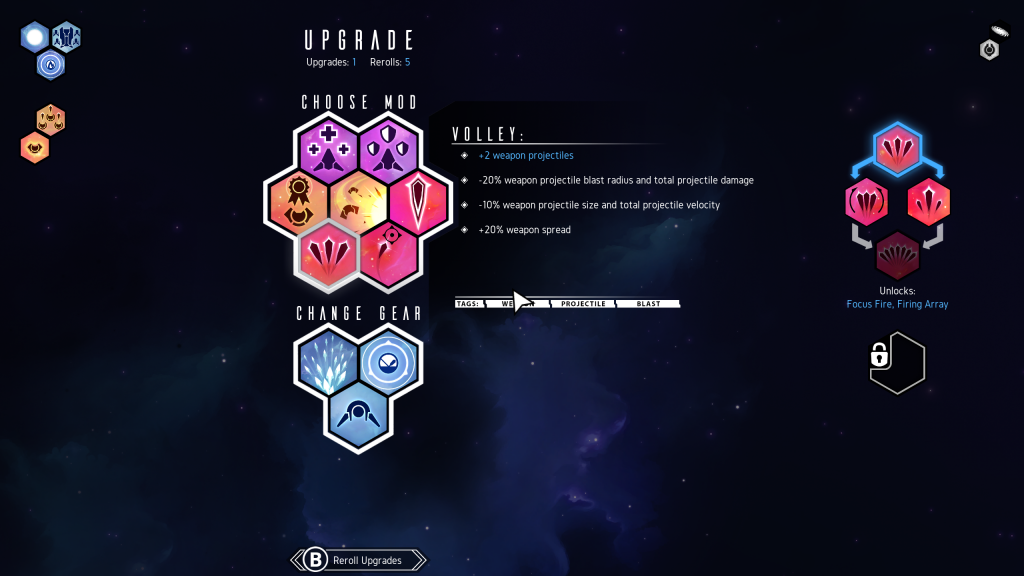
If Gear is your ship’s skeleton, Mods are the muscles, organs, and soul. Unlike Gear, which is limited to one per category, Mods can be stacked infinitely to fine-tune your playstyle.
Available after your first three level-ups (reserved for Gear), Mods are randomized per level-up, forcing you to adapt to what’s offered. Each Mod can be upgraded twice, with the first upgrade offering a stronger version or a risk-reward buff-debuff combo, and the second unlocking a final form that’s often a run-defining powerhouse. Here are some of the standouts:
- Drones – Spawns drones that can be commanded to circle you and attack nearby enemies or seek out targets.
- Flash Shielding – Speeds up shield regeneration, letting you recover faster after taking hits.
- Skirmish – Deals extra crash damage after firing your weapon. When you strike a foe with crash damage, your weapon’s next shot is now enhanced.
Although I haven’t unlocked all the Mods Nova Drift has to offer, there are easily over 100 to choose from, including upgrades. With such variety, you’ll rarely see every Mod in one run, keeping the rogue-lite replayability high.
Strategic mod selection is pivotal, shaping your build beyond mere weapon, shield, and body choices. Mods can supercharge your gear—boosting fire rate, expanding shield radius, fortifying hull health, or widening weapon spread. They let you fine-tune the balance between offense and defense or commit fully to one approach. Transform your ship into a lone berserker or command a fleet of drones and turrets to carry you through your run.
Despite the vast array of options, no build I’ve tried has felt overwhelmingly overpowered. Even experimental setups consistently carry me halfway through, rarely failing outright, even if not perfectly optimized or fitting of my playstyle. The game’s balance is surprisingly on point—a rare feat for rogue-lites, where equilibrium can often falter.
Challenge Modes — Risk and Reward
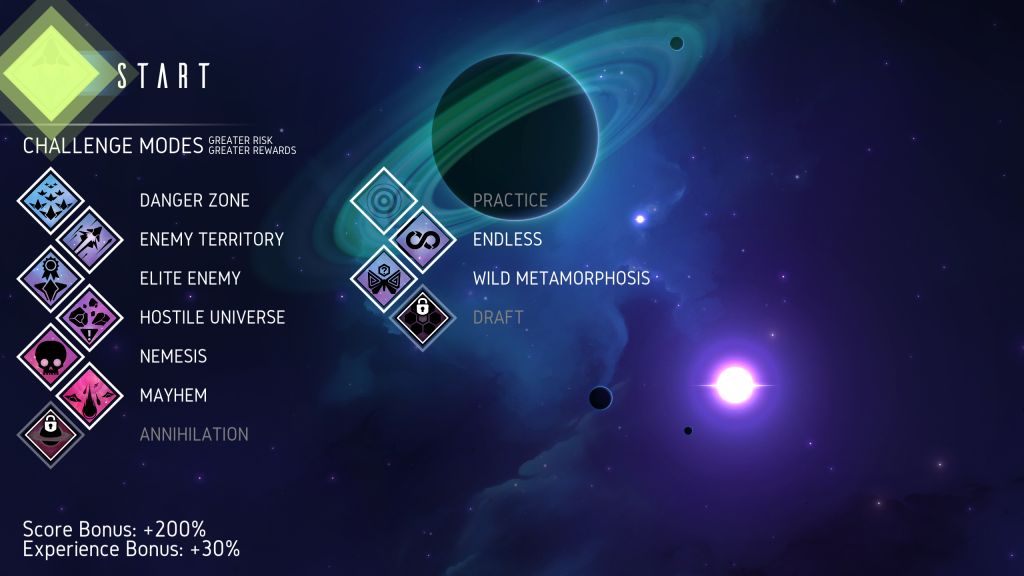
Challenge Modes are the final layer of Nova Drift’s progression, permanently unlocked after achieving score milestones or completing specific missions across runs. These optional modifiers increase difficulty by altering gameplay rules, but they reward you with percentage boosts to your score and XP, accelerating level-ups and unlocking new Gear and Mods faster within your runs.
You can activate multiple Challenge Modes simultaneously, stacking their effects for exponentially tougher runs and greater rewards. This risk-reward balance appeals to skilled players seeking a tougher challenge or those chasing Gear and Mod unlocks that become available in your run, though it can feel daunting if you aren’t prepared.
Each mode reshapes the experience, testing your build’s resilience and forcing new strategies, making them a brilliant way to extend replayability.
- Danger Zone – Waves advance faster, and enemies spawn more frequently, reducing downtime and overwhelming unprepared builds.
- Nemesis – Bosses are more powerful, with increased health and damage, making them deadly even after you’ve felled them a few times prior.
- Endless – After defeating the final battle for the first time, you unlock this challenge mode, which allows the game to continue infinitely until you are destroyed. Great for racking up as many points as you can.
Wild Metamorphosis — An Expansive Challenge
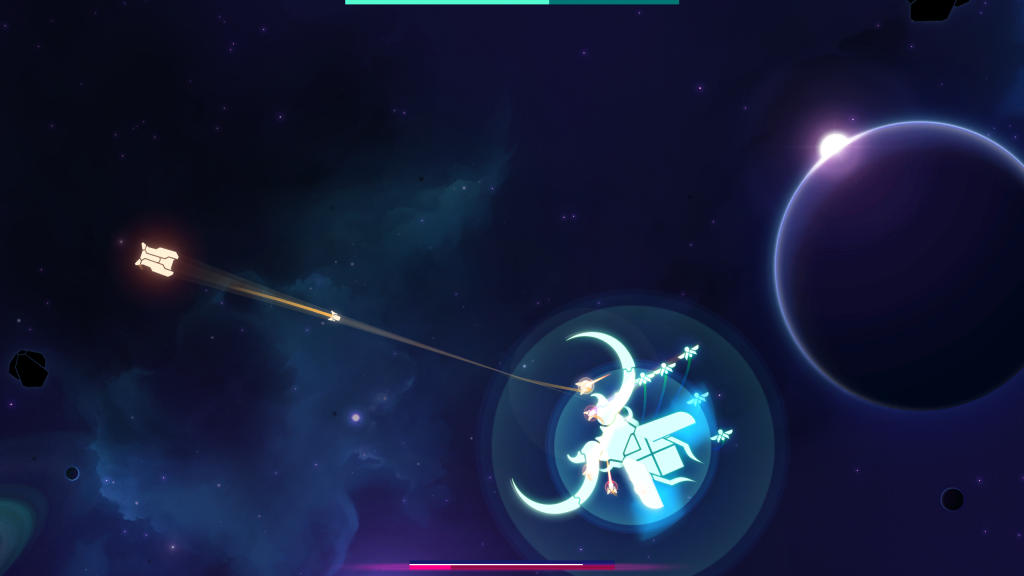
The standout Challenge Mode, Wild Metamorphosis, feels less like a challenge and more like a full-blown expansion. It reinvigorated my experience when I thought I’d exhausted Nova Drift’s content, delivering a second wind that kept me playing for hours more.
This mode introduces a suite of Wild Mods—powerful upgrades with drastic buffs and debuffs, stackable without upgrades for maximum flexibility. These Mods are high-risk, high-reward, letting you double or triple down on favorites for absurd builds.
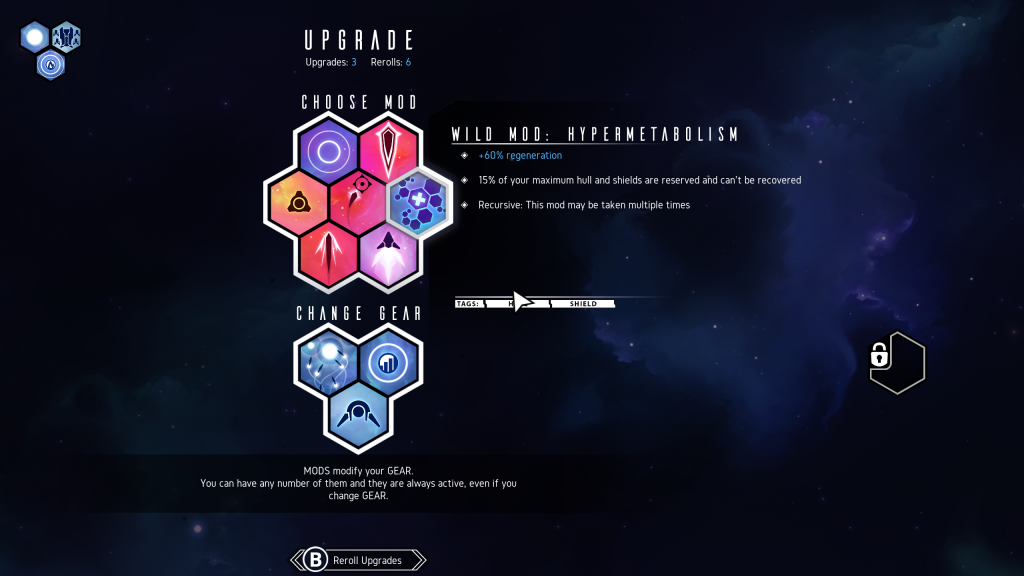
Additionally, Wild Metamorphosis randomizes boss encounters, replacing the standard mode’s predictable boss schedule with a roster of new and returning bosses. The randomized bosses add unpredictability, as you can’t rely on memorized patterns, making your later runs feel fresh.
This mode transforms Nova Drift into an even more rogue-lite experience, amplifying the chaos and rewarding adaptability. It’s the perfect capstone for players who’ve mastered the base game, offering new challenges and build possibilities that feel like a love letter to rogue-lite fans.
Accessibility Options — Tuning Your Experience
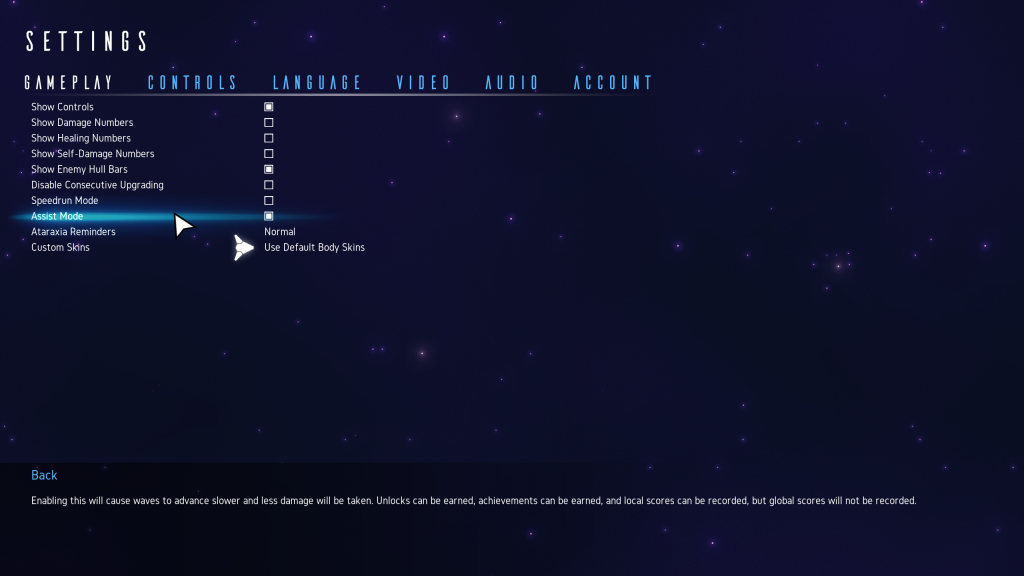
On the flip side of Challenge Modes, Nova Drift offers accessibility options to ensure players can enjoy the game, even if the base difficulty feels taxing. Assist Mode slows wave progression and reduces damage taken, while still allowing you to earn Unlocks and Achievements as well as record scores on the local leaderboard.
For better build tracking, you can enable visible damage, self-damage, and healing numbers to monitor your strengths and deficiencies. Auto Deploy Drones is enabled by default, but you can also opt for Auto Deploy Mines and Turrets or toggle Auto Firing for seamless control.
To enhance your visual experience, options include disabling screen shakes and flashes or activating a subtle effect behind your ship for improved visibility, ensuring a clearer and more comfortable playthrough.
Visuals and Audio — Functional but Forgettable
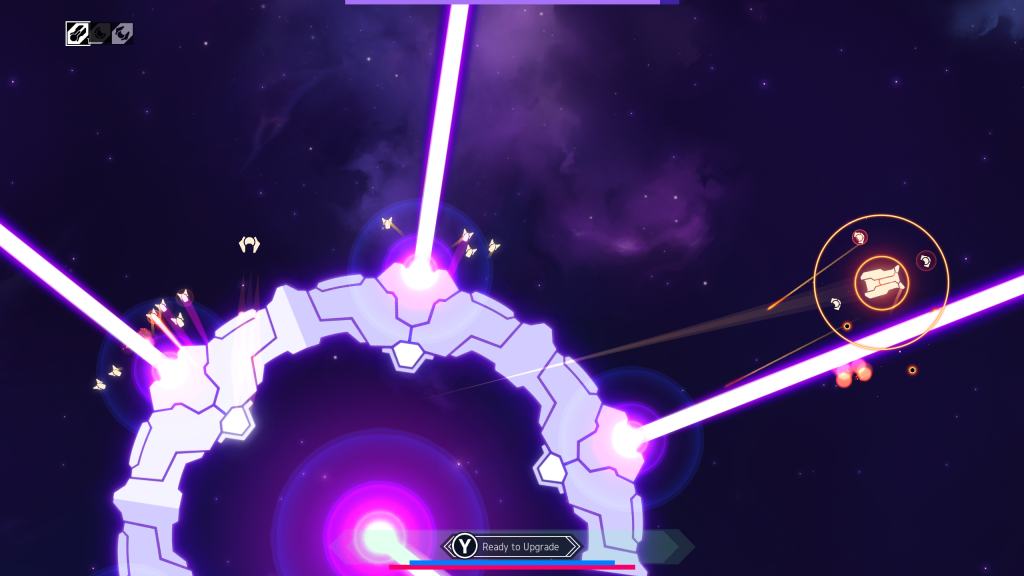
Nova Drift’s visuals are minimalist, with a static deep-space backdrop offset by vibrant, flashy attacks. It’s functional but doesn’t pop, and a dynamic background could’ve added flair.
Sound effects nail the arcade vibe, while the ambient drum & bass soundtrack ebbs and flows with the action. It’s immersive but forgettable, blending into one track without standout moments.
Final Thoughts on Nova Drift
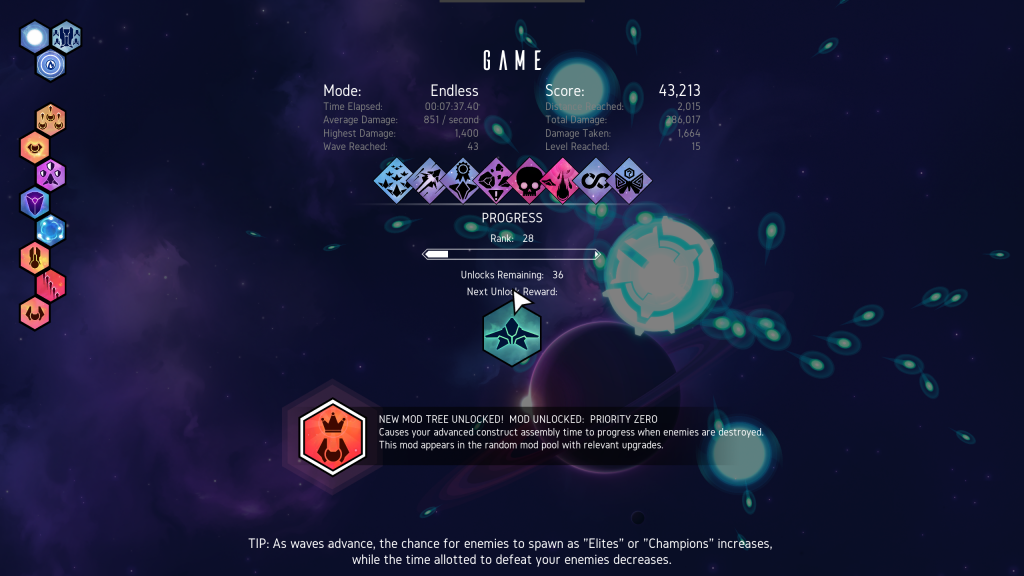
Nova Drift is a love letter to classic space shooters, modernized with rogue-lite depth and near-infinite build variety. Its tight controls, diverse enemies, robust Gear and Mod systems, and dynamic Challenge Modes—especially the game-changing Wild Metamorphosis—keep you hooked.
Although the classic feel can sometimes be its downfall in some instances, with no global leaderboard curbing long-term engagement. It’s a niche game, even for a rogue-lite, but a must-play for old school fans or even gamers looking for a rogue-lite that doesn’t have many comparisons. It isn’t visually or sonically flashy, and it can get a bit repetitive at times, but it’s a great game that knows what it wants to be and delivers a fair yet challenging experience that rewards skill and strategic build crafting.
Final Score: 7.7/10
Pros
- Deep Build Crafting
- Steady Unlocks Keep Gameplay Loop Fresh
- Challenging, yet Fair
- Wild Metamorphosis Unlock Feels Like an Expansion
- Tight, Arcade-like Controls
Cons
- No In-Game Global Leaderboard
- Unremarkable Presentation & Soundtrack
- Can Feel Repetitive

